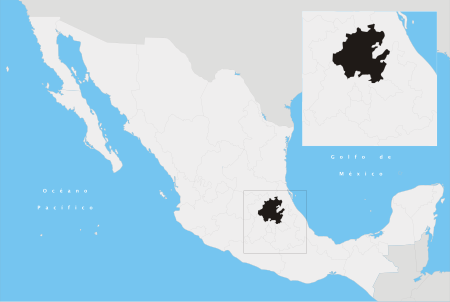Elemental
|
Read other articles:

2019 Spanish-language television series MonarcaGenreDramaCreated byDiego GutiérrezWritten by Sandra García Velten[1] Ana Sofía Clerici[1] Fernando Rovzar[1] Julia Denis[1] Starring Irene Azuela Juan Manuel Bernal Osvaldo Benavides Rosa María Bianchi Country of originMexicoOriginal languageSpanishNo. of seasons2No. of episodes18ProductionExecutive producerDiego GutiérrezProduction companies Ventanarosa[1] Lemon Studios[1] Stearns Castle[1&#…

Men's national football team representing Colombia This article is about the men's team. For the women's team, see Colombia women's national football team. ColombiaNickname(s)Los Cafeteros (The Coffee Growers)La Tricolor (The Tricolour)AssociationFederación Colombiana de Fútbol (FCF)ConfederationCONMEBOL (South America)Head coachNéstor LorenzoCaptainJames RodríguezMost capsDavid Ospina (128)Top scorerRadamel Falcao (36)Home stadiumEstadio Metropolitano Roberto Meléndez[1]FIFA codeCO…

American lawyer and former federal prosecutor (born 1968) Preet BhararaOfficial portrait, 2009United States Attorney for the Southern District of New YorkIn officeAugust 13, 2009 – March 11, 2017PresidentBarack ObamaDonald TrumpPreceded byMichael J. GarciaSucceeded byJoon Kim (acting) Personal detailsBornPreetinder Singh Bharara (1968-10-13) October 13, 1968 (age 55)Firozpur, Punjab, IndiaPolitical partyDemocraticSpouseDalya BhararaChildren3EducationHarvard University (BA)Columbi…

この項目には、一部のコンピュータや閲覧ソフトで表示できない文字が含まれています(詳細)。 数字の大字(だいじ)は、漢数字の一種。通常用いる単純な字形の漢数字(小字)の代わりに同じ音の別の漢字を用いるものである。 概要 壱万円日本銀行券(「壱」が大字) 弐千円日本銀行券(「弐」が大字) 漢数字には「一」「二」「三」と続く小字と、「壱」「弐」…

Cet article traite de l'équipe féminine. Pour l'équipe masculine, voir Équipe de Chypre de football. Cet article est une ébauche concernant une équipe nationale de football, le football féminin et Chypre. Vous pouvez partager vos connaissances en l’améliorant (comment ?) selon les recommandations des projets correspondants. Équipe de Chypre féminine Généralités Confédération UEFA Couleurs Bleu et blanc Classement FIFA 120e (15 décembre 2023)[1] Personnalités Sélectionneu…

English actor Frank CellierCellier in The 39 Steps, 1935Born(1884-02-23)23 February 1884Surbiton, Surrey, EnglandDied27 September 1948(1948-09-27) (aged 64)London, EnglandYears active1903–1946Spouses Florence Glossop-Harris (m. 1910; div. 1925) Phyllis Shannaw (m. 1925) ChildrenAntoinette CellierPeter CellierParent(s)François CellierClara Short Frank Cellier (23 February 1884 – 27 Septem…

American college football season 2001 Houston Cougars footballConferenceConference USARecord0–11 (0–8 C-USA)Head coachDana Dimel (2nd season)Co-offensive coordinatorDave Warner (1st season)Co-offensive coordinatorClancy Barone (1st season)Offensive schemeSpreadCo-defensive coordinatorDick Bumpas (3rd season)Co-defensive coordinatorBradley Dale Peveto (2nd season)Base defense4–3Home stadiumRobertson StadiumSeasons← 20002002 → 200…

لمعانٍ أخرى، طالع تابور (توضيح). تابور الإحداثيات 40°53′48″N 95°40′21″W / 40.896666666667°N 95.6725°W / 40.896666666667; -95.6725 [1] تاريخ التأسيس 1852 تقسيم إداري البلد الولايات المتحدة[2] التقسيم الأعلى آيوا خصائص جغرافية المساحة 3.335069 كيلومتر مربع (…

TaurierscomuneTauriers – Veduta LocalizzazioneStato Francia RegioneAlvernia-Rodano-Alpi Dipartimento Ardèche ArrondissementLargentière CantoneVallon-Pont-d'Arc TerritorioCoordinate44°33′N 4°17′E / 44.55°N 4.283333°E44.55; 4.283333 (Tauriers)Coordinate: 44°33′N 4°17′E / 44.55°N 4.283333°E44.55; 4.283333 (Tauriers) Superficie4,46 km² Abitanti189[1] (2009) Densità42,38 ab./km² Altre informazioniCod. postale07110 Fuso …

Independent research institution Institute for Palestine StudiesInstitute for Palestine StudiesAbbreviationIPSFormation1963TypeResearch InstituteHeadquartersAnis Nsouli Street, VerdunLocationBeirutWebsitepalestine-studies.org The Institute for Palestine Studies (IPS) is the oldest[1] independent nonprofit public service research institute in the Arab world. It was established and incorporated in Beirut, Lebanon, in 1963[2] and has since served as a model for other such institutes…

Methylphenylpiracetam Names IUPAC name 2-(5-Methyl-2-oxo-4-phenyl-pyrrolidin-1-yl)-acetamide Identifiers CAS Number 1301211-78-8 N[ChemSpider] 3D model (JSmol) Interactive image ChEMBL ChEMBL2391147 ChemSpider 30831670 PubChem CID 52912210 CompTox Dashboard (EPA) DTXSID601031901 InChI InChI=1S/C13H16N2O2/c1-9-11(10-5-3-2-4-6-10)7-13(17)15(9)8-12(14)16/h2-6,9,11H,7-8H2,1H3,(H2,14,16)/t9-,11-/m0/s1Key: ZTGRWYMPQCQTHD-ONGXEEELSA-N SMILES C[C@H]1[C@H](CC(=O)N1CC(=O)N)C2=CC=CC=C2 Pr…

AceAlbum mini karya TaeminDirilis18 Agustus 2014 (2014-08-18)GenreK-Pop,[1] Dance[2]Durasi20:31BahasaKoreaLabelS.M. Entertainment, KT MusicSingel dalam album Ace DangerDirilis: 18 Agustus 2014 (2014-08-18) Ace adalah album mini pertama dari Taemin yang dirilis pada 18 Agustus 2014 di bawah label SM Entertainment.[3] Singel promosi dari album ini adalah Danger. Latar belakang dan perilisan Pada 11 Agustus 2014, SM Entertainment mengumumkan bahwa Taemin akan m…

County in Nebraska, United States Not to be confused with Johnson, Nebraska. County in NebraskaJohnson CountyCountyJohnson County Courthouse in TecumsehLocation within the U.S. state of NebraskaNebraska's location within the U.S.Coordinates: 40°24′N 96°16′W / 40.4°N 96.27°W / 40.4; -96.27Country United StatesState NebraskaFounded1855 (founded)1857 (organized)Named forRichard Mentor JohnsonSeatTecumsehLargest cityTecumsehArea • Total377 s…

A heptagonal number is a figurate number that is constructed by combining heptagons with ascending size. The n-th heptagonal number is given by the formula H n = 5 n 2 − 3 n 2 {\displaystyle H_{n}={\frac {5n^{2}-3n}{2}}} . The first five heptagonal numbers. The first few heptagonal numbers are: 0, 1, 7, 18, 34, 55, 81, 112, 148, 189, 235, 286, 342, 403, 469, 540, 616, 697, 783, 874, 970, 1071, 1177, 1288, 1404, 1525, 1651, 1782, … (sequence A000566 in the OEIS) Parity The parity of hept…

Australian basketball team This article is about the professional NBL franchise. For the district's basketball association with the same team nickname, see Basketball Illawarra. Illawarra Hawks 2023–24 Illawarra Hawks seasonLeaguesNBLFounded1979; 45 years ago (1979)HistoryIllawarra Hawks1979–1998; 2015–2020; 2021–present Wollongong Hawks1998–2015The Hawks2020–2021ArenaWIN Entertainment CentreLocationWollongong, New South WalesTeam colorsBlack, red, white …

بوينغ سي-40 كليبرمعلومات عامةالنوع طائرة نقل عسكريبلد الأصل الولايات المتحدةالمهام executive transport (en) سعر الوحدة 70 مليون دولارالتطوير والتصنيعالصانع بوينغالكمية المصنوعة 19طورت من بوينغ 737سيرة الطائرةدخول الخدمة 21 أبريل 2001أول طيران 14 أبريل 1999 الخدمةالمستخدم الأساسي بحرية الول�…

Mausoleum monument in Ponce, Puerto Rico For the obelisk at Plaza Las Delicias, see Monumento a los heroes de El Polvorín (obelisk). Monumento a los heroes de El PolvorínImage of the mausoleum18°00′47.7714″N 66°37′58.2954″W / 18.013269833°N 66.632859833°W / 18.013269833; -66.632859833LocationCementerio Civil, Barrio Portugués Urbano, Ponce, Puerto RicoDesignerAlfredo Wiechers PierettiTypeTomb, obelisk, and statueMaterialStucco and ConcreteLengthapprox 40 fe…

خوان الباريث مينديثابال (بالإسبانية: Juan de Dios Álvarez Méndez) معلومات شخصية اسم الولادة (بالإسبانية: Juan de Dios Álvarez Méndez) الميلاد 25 فبراير 1790(1790-02-25)تشايكلانا دي لا فرونتيرا الوفاة 3 نوفمبر 1853 (63 سنة)مدريد مواطنة إسبانيا مناصب الحياة العملية المهنة سياسي، واقتصادي، و�…

هذه المقالة يتيمة إذ تصل إليها مقالات أخرى قليلة جدًا. فضلًا، ساعد بإضافة وصلة إليها في مقالات متعلقة بها. (فبراير 2021) اللهجة البئديشئرية هي واحدة من اللهجات الشمالية الرئيسية للغة أتشومي. اللغة الأتشومية هي فرع من لغات إيرانية غربية ولها جذر مشترك مع اللغة البهلوية.[1][…

Municipality and town in Hidalgo, MexicoEmiliano ZapataMunicipality and town Coat of armsEmiliano ZapataLocation in MexicoCoordinates: 19°39′N 98°33′W / 19.650°N 98.550°W / 19.650; -98.550Country MexicoStateHidalgoMunicipal seatEmiliano ZapataArea • Total36 km2 (14 sq mi)Population (2005) • Total12,309 Emiliano Zapata is a town and one of the 84 municipalities of Hidalgo, in central-eastern Mexico. The municipality …
